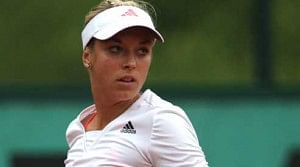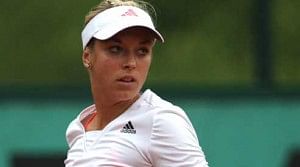
Wimbledon 2011 Week 1: Hype, Tears and Some Good Old Magic
Love it or hate it, the lack of play on the middle Sunday of Wimbledon, the most odd bow to tradition of them all, gives us plenty of time to leisurely reflect on the matches of the first week and breathlessly enhance our anticipation for the blockbuster second Monday (which may just qualify as the most momentous day of the tennis calendar, with its lineup of 16 high-profile 4th round matches) at the same time. Last year all anyone could talk about on Actionless Sunday were the Isner-Mahut saga and Roger Federer’s near-exit in the first round. This year, nothing has come close to the eye-popping drama of Isner-Mahut, but if you dared to suggest that there were no talking points in the first week of Wimbledon 2011, you’d probably be forced to either drown in Sabine Lisicki’s tears or have your eardrums burst by Novak Djokovic’s screams. Here’s a look at some of the highlights of Week 1:
Serena can out-sob the best of them, too: Maybe she wanted to prove that she’s better than everybody else not just in tennis prowess, but in post-match reactions too. A visibly emotional Serena Williams immersed herself in a gushing stream of tears after overcoming a spirited challenge from Frenchwoman Aravane Rezai in the first round. The stunned Centre Court crowd could hardly believe what they were witnessing, given that Serena, while never one to shy from lashing out her share of obscenities and theatrics during a match, is not the type to indulge in excessive drama after she’s done with her routine of blasting past her opponent. You’d have been forgiven for mistaking this to be the first time Serena had made a business-as-usual comeback victory after a year-long injury layoff.
The ever-changing Next Big Thing: At the Australian Open, we were convinced that Milos Raonic and Alexandr Dolgopolov were the best of the young guns, and the most likely candidates to take over men’s tennis in a few years’ time. At the French Open, we were made to unlearn everything we knew about the green generation of the ATP when Raonic and Dolgopolov crashed out early. And here, Bernard Tomic has just given us fairly strong indications that we were all idiots to think that anything could ever come in the way of Tomic and his world-beating ambitions. How good is Tomic? The question, perhaps, should instead be ‘how much better can Tomic get?’. While he showed tremendous maturity and court smarts in dispatching 5th seed Robin Soderling in the 3rd round, the 18-year-old Australian really has to do something about that leaden foot movement of his if he wants to reach the top of the sport. If he does do something about it, though, there is no telling just how high Tomic can rise. Sure, as Raonic and Dolgopolov and countless others before them have shown, it’s plain stupid to attach too much importance to a single Grand Slam performance when gauging the probable future of a youngster. But Tomic’s smooth, adaptable playing style and undoubtedly natural feel for the ball seem to suggest he’s the real deal.
The Female Goran Ivanisevic?: Sabine Lisicki can whale on the ball, as her atomic forehand and blistering backhand amply show. But that serve of hers is a force of nature. Down two match points at 3-5, 15-40 against French Open champion Na Li in the 2nd round, Lisicki unleashed a torrent of big serving the like of which has rarely been seen in women’s tennis. It was a display as clinical as it was passionate. As you watched her get ready to serve, her unblinking eyes staring into oblivion with a fierceness that was just a wee bit scary, you could almost hear her mind thinking, “Right – this is what I do best, so I’m going to lay it all on the court and see where it takes me”. It was hardly surprising that a jittery Li failed to serve out the match after being subjected to such a ferocious barrage of ball-striking. It wasn’t surprising, either, that Lisicki couldn’t hold back the tears when she finally clinched the win after a gargantuan struggle. Lisicki may not go on to be the next Williams, but she’ll always be remembered for channeling her inner Goran Ivanisevic in a way that no woman has ever quite managed to.

Sabine Lisicki
Testing those vocal cords: The next time you hear someone claim that grass has become the new clay, just go back and watch Novak Djokovic’s near-invincible performances during this year’s clay swing and compare them with his relative struggles at Wimbledon. The speed may be less than what it used to be, but there’s just something about the surface here in London – the low bounce? the skiddy nature? – that doesn’t suit the games of a vast majority of the players, including Djokovic’s. In his 3rd round match against Marcos Baghdatis, the Serb put in a performance that can be described as sketchy at best and awful at worst. Which is not to say there weren’t moments of jaw-dropping brilliance during the match. After one particularly spectacular point where Djokovic scrambled all over (and I mean literally all over) the court only to lose the point when a slice floated long, he could hold his frustration no longer and let his racquet bear the brunt of his anger, smashing it to pieces. The good thing about the 2011 Djokovic is that he believes he can win even when he’s playing his worst, which is exactly what he did against Baghdatis. After finally putting his opponent away by taking the 4th set 6-4, Djokovic let loose again, screaming his lungs out and punctuating his roars of celebration with vociferous fist-pumps. Has Djokovic expended too much energy to have enough gas left for the big matches of Week 2?
Adding fuel to the Hype Machine: As if we didn’t already have enough of the British media going overboard with their gushing over Andy Murray’s annual parade of hope, delirium and misery whenever he visits Wimbledon, we may now also have to deal with their overreactions to a female counterpart. Laura Robson gave Maria Sharapova all she could handle in the 2nd round, and predictably, there was no shortage of ‘a new star is born’ stories in the English newspapers. Robson does have an impressive arsenal of attacking shots and she seems far wiser than her years in her interviews, but it would be tragic if her fortunes were perennially burdened by the excessive expectations and attention piled on by the media, as Murray’s currently are. Whatever happened to the axiom ‘live and let live’?
The magic is back, kind of: A year removed from the surest sign – a quarterfinal exit at his beloved Wimbledon – of the start of his decline, Roger Federer seems to have rolled back the years, if only for a few days. He has barely put a foot wrong through his first 3 matches, and he seems just as sure of himself on the grass as he ever has. Watching Federer’s matches in his twilight years has become something of a confusing exercise – is he a step slow, or is he as agile as he was in his prime years? Does his serve lack the pop of his glory days, or is it as razor sharp as ever? Has the forehand lost some of its sting, or is it still the most lethally impregnable weapon ever seen in tennis history? His match against Mikhail Youzhny tomorrow may not give too many clear answers, but his probable quarterfinal against the red-hot Jo-Wilfried Tsonga almost certainly will. Until then, we may as well just sit back and enjoy the magic while it lasts.